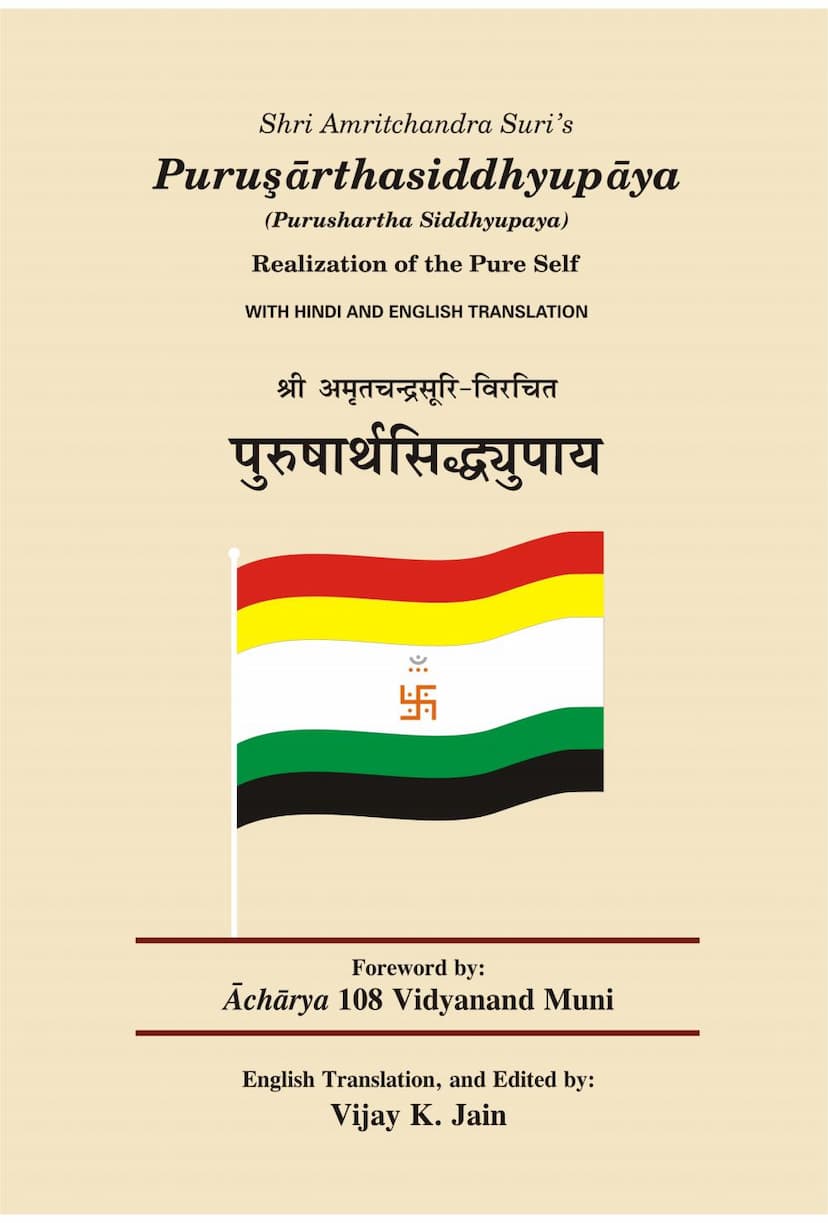Purushartha Siddhupaya
Added to library: September 2, 2025

Summary
Summary of "Purushartha Siddhi Upaya" by Amritchandra Acharya
Overview:
"Purushartha Siddhi Upaya" (The Means to the Realization of the True Self) is a seminal Jain text authored by Acharya Amritchandra Suri, a renowned scholar of the 10th century CE. This work, meticulously translated and edited by Vijay K. Jain, serves as a comprehensive guide for householders (shravakas) seeking spiritual liberation. It elucidates the practical path to achieving the ultimate goal of life, which is self-realization and freedom from the cycle of birth and death (samsara). The book emphasizes the Jain principles of Anekantavada (manifoldness of viewpoints) and the Triratna (Three Jewels: Right Faith, Right Knowledge, and Right Conduct) as the foundation for spiritual progress.
Core Teachings and Structure:
The text systematically outlines the Jain path to liberation, focusing on the practical application of its core tenets for lay practitioners. It is structured to guide the reader from fundamental principles to advanced practices:
- Introduction and Invocation: The text begins with invocations to the supreme effulgence (omniscience) and the doctrine of Anekanta, highlighting their foundational importance in Jain philosophy.
- The Nature of the Soul: It describes the soul (Atman) as pure consciousness, distinct from its physical attributes and karmic modifications, emphasizing its inherent qualities of omniscience and bliss.
- The Path to Liberation (Moksha Marga): The central theme revolves around the Triratna – Right Faith (Samyagdarsana), Right Knowledge (Samyagjnana), and Right Conduct (Samyakcharitra) – as the indispensable means to achieve liberation.
- Right Faith (Samyagdarsana): This is the cornerstone, involving a firm and unwavering belief in the fundamental Jain truths (tattvas) without doubt or misapprehension. It involves not desiring worldly riches, celestial pleasures, or adhering to erroneous doctrines. It also emphasizes detachment from revulsion and delusion.
- Right Knowledge (Samyagjnana): Acquired through diligent study and understanding of the scriptures, right knowledge is the correct perception of reality, free from doubts and misapprehensions. It is presented as the effect of right faith, which is the cause.
- Right Conduct (Samyakcharitra): This is the practical manifestation of right faith and knowledge, achieved by abstaining from all sinful activities and passions. It is described as the soul's pure, untainted, and unattached nature.
- The Vows (Vratas): The text elaborately details the five small vows (anu vratas) for householders and their transgressions (aticharas). These vows are extensions of the principles of non-violence (ahimsa), truthfulness (satya), non-stealing (achaurya), chastity (brahmacharya), and non-possession/non-attachment (aparigraha).
- Ahimsā (Non-injury): This is paramount, stemming from the control of passions. It extends to abstaining from harm to all living beings, including both mobile (trasa) and immobile (sthāvara) creatures. The text strongly advocates for vegetarianism and abstaining from wine, meat, honey, and certain fruits (udumbaras) due to their involvement in causing harm.
- Satya (Truthfulness): Speaking truthful, beneficial, and pleasant words, avoiding falsehood in various forms like misleading advice, forgery, and gossip.
- Achaurya (Non-stealing): Not taking what is not given, and refraining from theft, abetment of theft, and fraudulent practices.
- Brahmacharya (Chastity/Celibacy): Maintaining chastity, controlling sexual passions, and abstaining from illicit relationships.
- Aparigraha (Non-possession/Non-attachment): Limiting one's possessions, both internal (passions, wrong beliefs) and external (wealth, property), and cultivating contentment.
- Supplementary Vows (Guna Vratas and Shiksha Vratas): The text further elaborates on the supplementary vows that reinforce the minor vows:
- Dik Vrata: Abstinence from activities beyond prescribed directional limits.
- Desha Vrata: Further limiting activities within specific regions for a set period.
- Anarthadanda Vrata: Refraining from purposeless sinful activities like gambling, harmful thoughts, and listening to evil stories.
- Sāmāyika: Periodic meditation and equanimity, aiming for oneness with the Self, practiced daily.
- Proṣadhopavāsa: Fasting on specific holy days, reinforcing self-control and detachment.
- Bhogopabhoga Parimāņa: Limiting the use of consumable and non-consumable objects, thereby reducing harm.
- Atithi Samvibhaaga Vrata: Offering charity to worthy ascetics with utmost reverence and purity.
- Sallekhanā (Voluntary Death): The text describes the practice of sallekhanā, a gradual withdrawal from worldly engagements and passions, undertaken with equanimity at the end of life, not as suicide but as a final act of spiritual discipline.
- Austerities (Tapa): Both external (bahya tapa) and internal (antaranga tapa) austerities are explained as vital for purification and spiritual progress. External austerities include fasting, reduced diet, living in solitude, abstaining from stimulating foods, mortifying the body, and restricting food intake. Internal austerities involve reverence, service, expiation, self-study, meditation, and renunciation.
- The Ten Virtues (Dasha Dharma): The text outlines ten supreme virtues – forbearance, modesty, straightforwardness, purity, truthfulness, self-restraint, austerity, renunciation, non-attachment, and celibacy – as essential for spiritual growth.
- Twelve Reflections (Bhavana): The importance of contemplating twelve reflections (impermanence, helplessness, transmigration, loneliness, distinctness, impurity, influx, stoppage, dissociation, the universe, rarity of enlightenment, and true religion) is highlighted to foster detachment and spiritual resolve.
- Enduring Hardships (Pariṣaha Jaya): The text lists twenty-two hardships that ascetics must endure with equanimity, including hunger, thirst, cold, heat, insect bites, etc., to conquer suffering and karmic attachments.
- Bondage and Liberation: The text clarifies how karmic bondage occurs through activities (yoga) and passions (kaṣāya), and how the Triratna leads to liberation by purifying the soul from these karmic influences. It emphasizes that the soul, in its pure state, is identical with the Triratna.
- Conclusion: The book concludes by reiterating that the householder, by diligently practicing the Triratna and adhering to the vows and supplementary vows, can achieve liberation, the ultimate goal of life. The author, Acharya Amritchandra, humbly attributes the composition to the inherent nature of scriptures and the reader's capacity for understanding, rather than his own effort.
Significance:
"Purushartha Siddhi Upaya" is highly valued for its clear and practical exposition of Jain philosophy and practice, tailored specifically for householders. It demystifies complex concepts and provides a step-by-step guide for spiritual advancement, making the path to liberation accessible and actionable. The translation by Vijay K. Jain makes this profound work available to a wider audience, fostering spiritual and moral development within the Jain community and beyond.